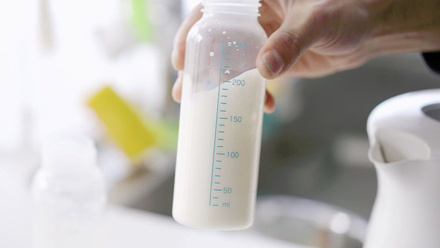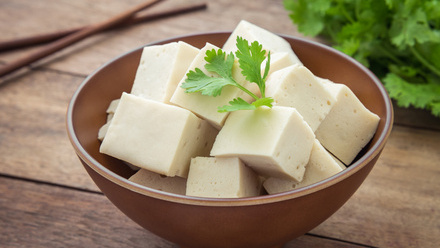These spiced, glazed fruit buns with flour-paste crosses are served as a traditional Easter treat – but you can enjoy them at any time of year.
They are delicious served freshly baked, which means there’s no need to spread them with butter or margarine. Any buns that don’t get eaten straightaway can be split and toasted the following day.
Ingredients
225g strong white bread flour (plus extra for kneading)
225g wholemeal flour
1 x 5ml spoon salt
1 x 15ml spoon ground mixed spice
35g caster sugar
50g unsaturated fat spread
1 orange (zest only)
7g fast-action dried yeast
100g dried mixed fruit
1 egg
300ml semi-skimmed milk
Vegetable oil for greasing
Crosses
50g strong white bread flour
4–5 x 15ml spoons cold water
Glaze
1 x 15ml spoon apricot jam
Equipment
Weighing scales
Sieve
Measuring spoons
Large mixing bowl
Wooden spoon
Grater
2 x Small mixing bowl
Fork
Measuring jug
2 x Small saucepan
Pan stand
Pastry brush
Clingfilm
Clean tea towel
2 x Baking tray
Disposable piping bag OR sandwich bag
Scissors
Oven gloves
Cooling rack
Instructions
Buns
- Sift both flours, the salt and spice into the large mixing bowl. Add the sugar and mix everything together with the wooden spoon.
- Rub the spread into the flour, spice and salt, using your fingertips, until the mixture looks like breadcrumbs.
- Grate in the zest of the orange and stir into the flour together with the dried yeast and mixed fruit using a wooden spoon.
- Crack the egg into a small bowl and beat with a fork.
- Pour the milk into the small saucepan and heat very gently for a short time over a low heat until it is tepid (hand hot).
- Make a well in the centre of the flour mixture. Add the beaten egg and three-quarters of the warm milk and mix together with the wooden spoon to form a soft dough. Add more milk if the mixture is too dry.
- Turn out the dough onto a lightly floured surface and knead well for 5–10 minutes until smooth and elastic. Place the dough back into the large mixing bowl.
- Use the pastry brush to grease a piece of clingfilm with some vegetable oil and place it directly on top of the dough. Cover with a clean tea towel and place in a warm place to rise for 1 hour or until the dough has doubled in size.
- Grease two baking trays with more of the oil.
- Turn out the dough onto a lightly floured board and knock out the air by kneading well again for 2 minutes.
- Divide the dough into 16 equal pieces and shape into round balls. Place the balls onto the two greased baking sheets and flatten them slightly with the palm of your hand.
- Grease two large pieces of clingfilm with oil and place them over the buns. Put the trays in a warm place until the buns have doubled in size. About 15 minutes before the end of the rising time, preheat the oven to 200°C/180°C fan or gas mark 6.
Flour-paste crosses
- Place the flour in a small bowl. Add the water 1 x 15ml spoon at a time, mixing well with a small spoon until you have a smooth paste. The paste should be thin enough to be piped but not too runny.
- When the buns have risen, carefully remove the clingfilm. Spoon the paste into a disposable piping bag or sandwich bag, carefully snip the very end (2mm) off the bag with scissors and pipe a cross onto each bun. (Practise your piping on a board first.)
- Place the buns in the oven and cook for 15–20 minutes, or until golden brown.
Glaze
- A few minutes before the buns are completely cooked, put the apricot jam into a small saucepan set over a low heat and cook, stirring with a wooden spoon, until runny.
- Brush the runny jam glaze over the cooked buns using a pastry brush as soon as they come out of the oven. Place onto a rack to cool for 10 minutes.
Skills used include:
Weighing, measuring, grating, sifting, beating, rubbing-in, mixing/combining, kneading and baking.
Top Tips
- If you don’t have a suitable warm place where the dough can be left to rise, place baking trays of covered buns over a washing-up bowl half-full of very hot water. Make sure these bowls are placed safely out of reach of children.
Something to try next time
- Leftover Hot Cross Buns can also be used to make our Bread and Butter Pudding.
Prepare now, eat later
- Make the dough one day and shape it the next. Prepare up to step 10, put the dough in a large oiled plastic bag and place in the refrigerator overnight. Next day it will have doubled in size, so knock it back and make up the buns following the remaining steps. This method is called ‘using a slow rise’.
- Cooked buns can be stored in an air tight container and frozen for up to 3 weeks.







